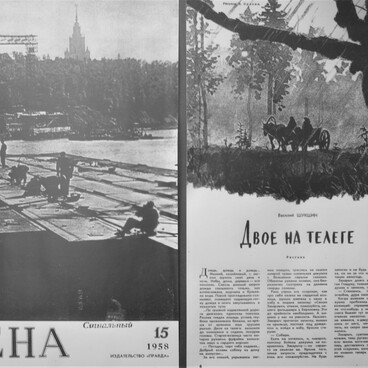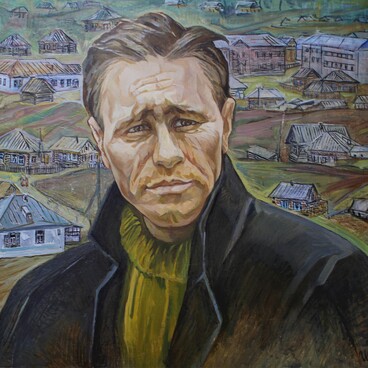Vasily Shukshin with his Classmates Kim En Sol and Irma Raush during the Rehearsal of an Educational Scene
The photograph was taken by an unknown author in 1955. Vasily Shukshin is depicted with his fellow students Kim En Sol and Irma Raush while rehearsing an educational scene.
From 1954 to 1960, Shukshin studied at the Directing and Production Faculty of the Gerasimov Institute of Cinematography (VGIK) in the workshop of Mikhail Romm. Valentin Vinogradov, Alexander Gordon, Alexander Mitta, Dina Musatova, Irma Raush, Kim En Sol, Andrei Tarkovsky, Julius Fait, and others were Shukshin’s groupmates.
The director remembered the following about his student years, “I came to the Institute as a deeply rural person, being a long way from art. I thought everyone could see it. I enrolled too late — at the age of 25, my erudition and knowledge were quite limited. It was challenging for me to study, extremely challenging …”.
Classmates and professors spoke of Shukshin cordially. Director Alexander Gordon wrote: “Vasya Shukshin was a bright person in our class, a person who unlike any of us. For the first two years he wore a dark blue navy tunic made of diagonal cloth with black “civilian” buttons, and military boots on his feet. He had sharp ears and kept his incredible accent and tone for the rest of his life, deliberately not spoiling it with the correct literary speech. This is a rare case. And no one dared to correct him. On the contrary, we liked it. Shukshin became a favourite not only of our workshop, but of almost all students at the Directing and Acting Department.
I vividly remember his first silent scene, or rather a scene with imaginary objects. The actor has nothing in his hands: no pen, no feather, no hammer, no axe. However, we must discern what he shows, what he is doing from his activity. So, Vasya comes out onto the stage, looks around, throws off an imaginary object from his shoulder — jacket is our guess. He removes a “scythe” from his shoulder, sharpens it with “bar” tied to his belt. Then he begins to wave the imaginary scythe, and gradually, with measured steps, moves along the “field”. Apparently, he knows this activity well. There he goes step by step, pressing the “scythe” by the “heel”. Tired, he sits down to rest, to smoke — and everything is in the same vein: he pulls out a “pouch” from his pocket, pours in “tobacco”, rolls a “cigarette”, spits on it, lights it up, and exhales happily, while wiping sweat from his forehead with a palm… And we, the audience, are completely immersed in his world. We found ourselves in the field, we felt the fresh smell of mown grass. He attracted the attention of the audience like a magnet, without making any special efforts. Experienced educators and students from other classes sat at rehearsals or exams with bated breath: a new talent was born before their eyes. Such people blessed with talents are called naturals …’.
The photograph was taken by an unknown author in 1955. Vasily Shukshin is depicted with his fellow students Kim En Sol and Irma Raush while rehearsing an educational scene.
From 1954 to 1960, Shukshin studied at the Directing and Production Faculty of the Gerasimov Institute of Cinematography (VGIK) in the workshop of Mikhail Romm. Valentin Vinogradov, Alexander Gordon, Alexander Mitta, Dina Musatova, Irma Raush, Kim En Sol, Andrei Tarkovsky, Julius Fait, and others were Shukshin’s groupmates.
The director remembered the following about his student years, “I came to the Institute as a deeply rural person, being a long way from art. I thought everyone could see it. I enrolled too late — at the age of 25, my erudition and knowledge were quite limited. It was challenging for me to study, extremely challenging …”.
Classmates and professors spoke of Shukshin cordially. Director Alexander Gordon wrote: “Vasya Shukshin was a bright person in our class, a person who unlike any of us. For the first two years he wore a dark blue navy tunic made of diagonal cloth with black “civilian” buttons, and military boots on his feet. He had sharp ears and kept his incredible accent and tone for the rest of his life, deliberately not spoiling it with the correct literary speech. This is a rare case. And no one dared to correct him. On the contrary, we liked it. Shukshin became a favourite not only of our workshop, but of almost all students at the Directing and Acting Department.
I vividly remember his first silent scene, or rather a scene with imaginary objects. The actor has nothing in his hands: no pen, no feather, no hammer, no axe. However, we must discern what he shows, what he is doing from his activity. So, Vasya comes out onto the stage, looks around, throws off an imaginary object from his shoulder — jacket is our guess. He removes a “scythe” from his shoulder, sharpens it with “bar” tied to his belt. Then he begins to wave the imaginary scythe, and gradually, with measured steps, moves along the “field”. Apparently, he knows this activity well. There he goes step by step, pressing the “scythe” by the “heel”. Tired, he sits down to rest, to smoke — and everything is in the same vein: he pulls out a “pouch” from his pocket, pours in “tobacco”, rolls a “cigarette”, spits on it, lights it up, and exhales happily, while wiping sweat from his forehead with a palm… And we, the audience, are completely immersed in his world. We found ourselves in the field, we felt the fresh smell of mown grass. He attracted the attention of the audience like a magnet, without making any special efforts. Experienced educators and students from other classes sat at rehearsals or exams with bated breath: a new talent was born before their eyes. Such people blessed with talents are called naturals …’.

